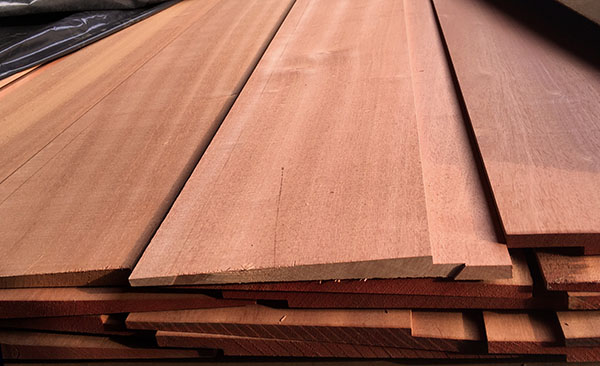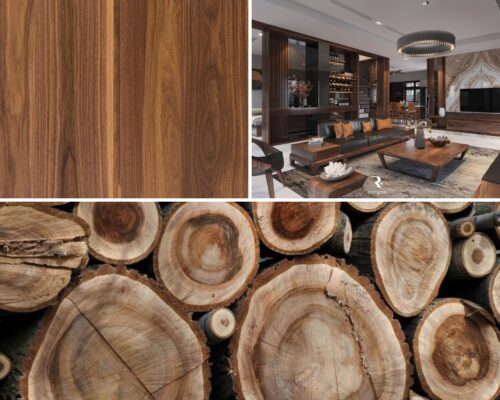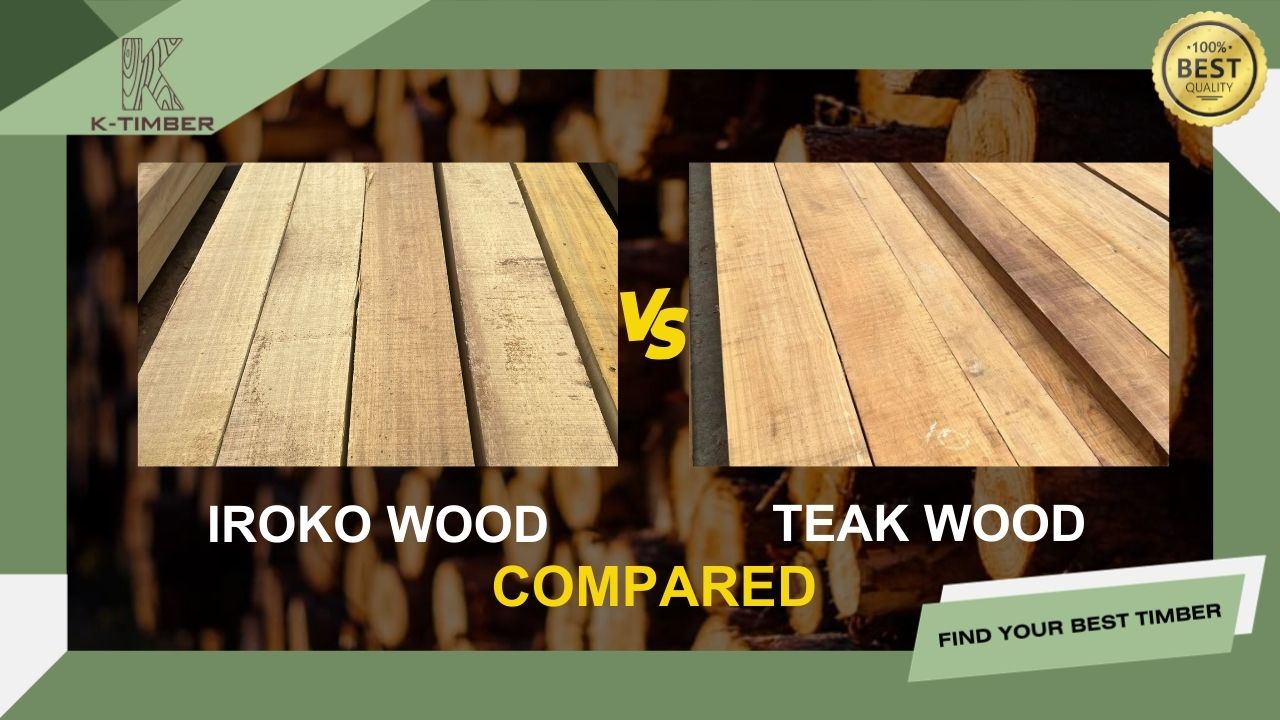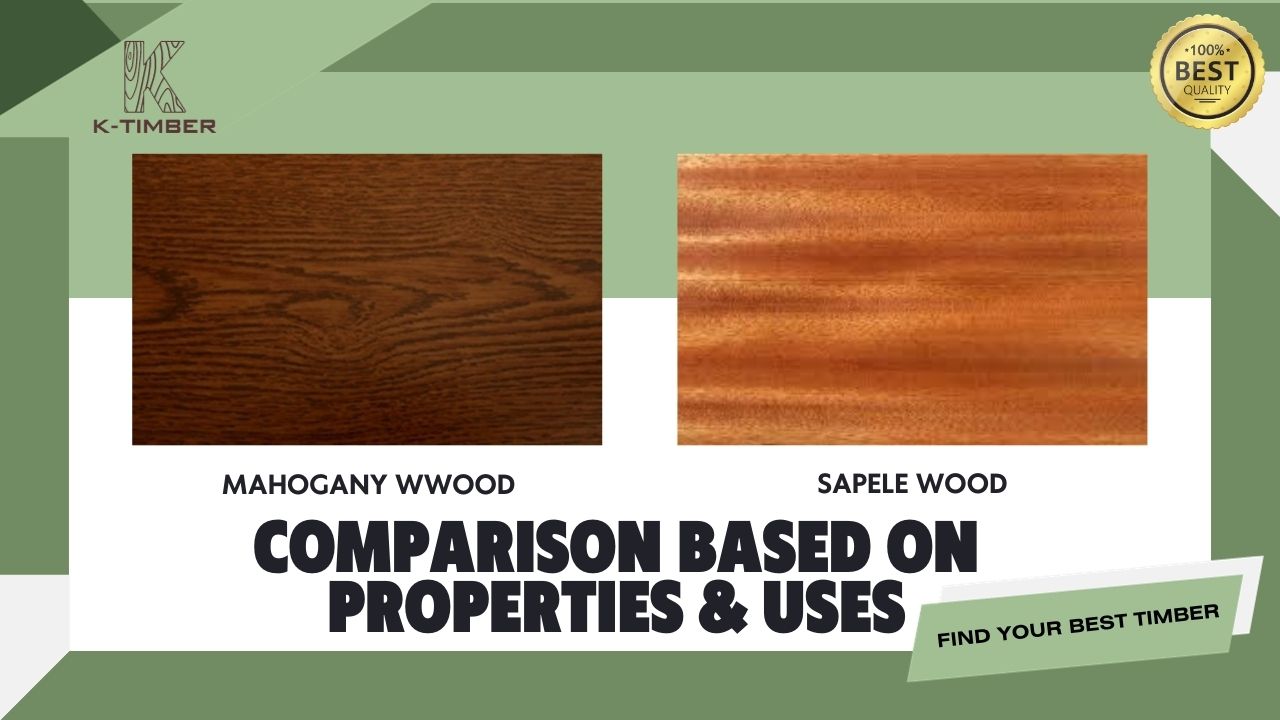When it comes to choosing the right type of wood for furniture, flooring, or architectural details, understanding the properties of different woods is very important. Sapele wood versus Walnut are two prominent materials in the woodworking world, and each has its own unique properties and aesthetics. However, many K-TIMBER customers still do not fully understand this type of wood, and they are uncertain about which wood to choose for their project. Let’s explore the differences between Sapele wood and Walnut in the article below with K-TIMBER.

Table of Contents
Introduction to Sapele Wood vs Walnut
Sapele wood and Walnut are two popular types of hardwood used in many countries in Europe and America due to their aesthetic appeal and high durability.
Sapele Wood
Sapele wood is a type of hardwood that originates from the tropical forests of Africa. Sapele typically has a reddish-brown color with grain and texture ranging from medium to fine. It is widely used in furniture production because of its high durability and excellent strength. If you are looking for a type of wood that can last over time, Sapele would definitely be a suitable choice.
Sapele features a golden to dark reddish-brown color that deepens over time, and it often exhibits an attractive interlocking grain pattern that enhances its visual appeal, particularly when finished. This wood is commonly used in the manufacture of furniture, paneling, and musical instruments, highlighting its versatility and enduring popularity.
READ MORE: Sapele Wood: Properties, Characteristics & Uses

Walnut wood
Walnut wood, particularly Black Walnut, is native to Eastern North America but is also cultivated in various parts of the world due to its valued wood. It is known for its rich, dark color that can range from a lighter pale brown to a dark chocolate brown with darker brown streaks. The wood often features a straight grain, though it can sometimes have a wavy or curly grain pattern that makes it highly sought after for decorative pieces. Walnut is relatively hard, durable, and shock-resistant, but it is also easy to work with, making it a top choice for artisans and woodworkers. It is predominantly used in the creation of high-end furniture, cabinetry, and other fine woodcrafts, as well as in gunstocks and automotive interiors.

Compare Sapele wood vs Walnut
| Category | Sapele wood | Walnut wood |
| Price | Prices vary from $11.99 to $13.99 per board foot, with potential discounts for bulk orders. | Prices range from $11.99 to $20.99 per board foot, depending on the quality. |
| Janka Hardness | Sapele has a Janka hardness score of 1410, indicating good resistance to wear and tear. | Walnut has a Janka hardness score of 1010, making it softer than Sapele. |
| Durability | Highly durable, suitable for high-traffic areas and furniture prone to heavy use. | Durable but more susceptible to scratches and dents compared to Sapele. Ideal for furniture and cabinetry. |
| Species | Known as African mahogany, Sapele belongs to the genus Entandrophragma of the family Meliaceae, closely resembling true mahogany but harder and more stable once in place. | Belongs to the genus Juglans in the Juglandaceae family, native to the Mediterranean but grown worldwide. |
| Tree Size | Can grow over 150 feet tall, resulting in larger wood diameters compared to walnut. | Smaller trees, generally 20-60 feet tall with a rounded canopy and larger, darker green leaves. |
| Location | Native to Africa, thriving in tropical regions with full sun and well-drained soils. | Native to the Mediterranean, also widely grown in North America, Europe, and Asia, preferring temperate climates with well-drained soil. |
| Color | Deep reddish-brown with possible purple or black stripes. Leaves are shiny and dark green. | Typically chocolate brown with possible dark streaks and a slight purple hue. Consistent coloration. |
| Grain | Interlocked grain making it visually interesting but harder to work with. Both woods are good with stains and polishes. | Straight grain with larger, more spaced-out pores giving it a rougher texture but easier to work with. |
| Rot Resistance | Extremely resistant to rot, used in boatbuilding. | Moderately resistant to rot, enhanced by its chemical properties and low density. |
| Sustainability | Fast-maturing (ready for harvest in about 20 years), making it more sustainable. Efforts include scaled-back production and new tree farms. | Takes longer to mature (40-60 years), making it less sustainable due to its slower growth rate and rarity. |
| Uses | Versatile: used in furniture, flooring, interior trim, and musical instruments. | Commonly used for furniture, cabinetry, gunstocks, veneers, and decorative items like cutting boards and dining tables. |
| Related Species | Part of the mahogany family, sometimes referred to as African mahogany. Related species are found in tropical Africa. | About 30 related species mostly found in the southern hemisphere, with some in the northern hemisphere as well. |
Sapele wood vs Walnut: Advantages and disadvantages
| Sapele wood | Walnut wood | |
| Advantages | Sapele is highly durable, making it great for high traffic areas. Twisted wood grain and easy machining ability. | The outstanding advantage of Walnut wood is its high sturdiness and durability. Walnut wood is also commonly used in furniture because of its beautiful wood patterns. |
| Disadvantages | Sapele is quite expensive and difficult to find | Walnut wood is easily scratched and distorted and is not suitable for heavy use. The price is higher than some other types of wood. |
What is the best project for Walnut wood?
If you are looking for a type of wood that not only enhances aesthetic value but also brings a luxurious and upscale feel to your living space, then Walnut wood is an option you cannot overlook. Known as a premium wood, Walnut is commonly used in the production of luxury furniture and flooring, due to its dark and rich color.
Walnut is not only favored for its attractive appearance but also for its durability and sturdiness. This is why it becomes a preferred choice for crafting wardrobes, bookshelves, and other storage solutions.
Moreover, Walnut is highly valued for its ability to withstand the test of time. This characteristic makes Walnut an optimal choice for those who wish to make a long-term investment in the quality and ever-increasing beauty of their living space.

What is the best project for Sapele wood?
Sapele is not only highly regarded in the woodworking industry for its many outstanding advantages, making it the top choice for many interior and construction projects. Sapele wood surfaces feature attractive, intricate grain patterns with impressive twists.
Furthermore, Sapele can be finished in various ways, from glossy to matte, suiting a variety of design styles. Sapele is not only popular for making furniture like tables, chairs, or wardrobes but is also favored for creating interior paneling, doors, and other house components. With its sturdiness and high durability, Sapele is very suitable for areas with high stress and traffic such as staircases.
Additionally, Sapele’s high versatility also allows for its widespread use in exterior applications, from outdoor walls to ceilings and porch floors. Sapele wood has good weather resistance, not easily damaged by temperature or humidity changes, thus meeting the stringent requirements of outdoor environments.

If you are looking to purchase high-quality, reliable Sapele wood online, you can contact K-TIMBER, a leading global supplier of African wood. K-TIMBER is a distributor and supplier of mainstay Angolan hardwood products such as Sapele, Iroko, Eucalyptus, Sipo, Acajou, etc., to FAS standards. With a commitment to quality and sustainability, K-TIMBER supplies Sapele wood from sustainably managed forests, ensuring superior quality and compliance with all regulations on logging and wood export in Angola. Not only providing quality wood, K-TIMBER also offers its customers wood at prices 20% lower than the market, meeting the criteria of GOOD QUALITY – GOOD PRICE. Contact K-TIMBER now to receive a quote for Sapele wood and related information.




![[K-Timber] Blog Post Boder](https://k-timbers.com/wp-content/uploads/2024/07/K-Timber-Blog-Post-Boder-2.png)





